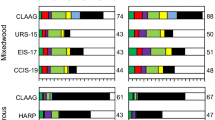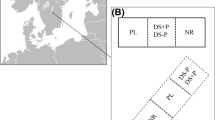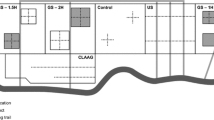Abstract
Enrichment planting is a technique that is gaining recognition for its potential to restore native forests. Due to the steep economic trade-offs involved and dearth of silvicultural and ecological knowledge about native flora, however, it remains unclear whether it has promise for widespread application. Focusing on growth performance, this study explores the restoration potential of twenty-one native tree species 3 years after planting in the understory of a rubber plantation in southern Bahia, Brazil. We tested the effects of slope, aspect, successional guild and basal area of the overstory rubber trees on the enriched species’ height, root collar diameter, and diameter at breast height. Height was the growth parameter that most differentiated species, with Parkia pendula, Sloanea monosperma, and Tachigali densiflora being three of the most successful species. Pioneer species grew faster than the non-pioneer species. Overstory basal area was the most important variable influencing the performance of the planted tree seedlings, while aspect and slope were less important. For every additional unit of basal area per hectare of rubber, there was an incremental decrease in the growth rates of the enrichment species. This suggests that the tree species are likely limited by available light, and that there are distinct trade-offs between overstory rubber density and understory tree species growth that are important to consider when accelerating forest recovery by using enrichment planting techniques.



Similar content being viewed by others
References
Aide TM, Zimmerman JK, Pascarella JB, Rivera L, Marcano-Vega H (2000) Forest regeneration in a chronosequence of tropical abandoned pastures: implications for restoration ecology. Restor Ecol 8(4):328–338. doi:10.1046/j.1526-100x.2000.80048.x
Alencar AL, Marangon LC, Feliciano ALP, Ferreira RLC, Teixeira LJ (2011) Regeneração natural avançada de espécies arbóreas nativas no sub-bosque de povoamentos de Eucalyptus saligna Smith. na zona da mata sul de Pernambuco. Ciência Florestal 21(2):183–192
Amador DB, Viana VM (2000) Dinâmica de “capoeiras baixas” na restauração de um fragmento florestal. Sci For 57:69–85
Ashton MS, Gunatilleke CVS, Singhakumara BMP, Gunatilleke, IAUN (2001) Restoration pathways for rain forest in southwest Sri Lanka: a review of concepts and models. Forest Ecol Manag 154(3):409–430. doi:10.1016/S0378-1127(01)00512-6
Bazzaz FA (1979) The physiological ecology of plant succession. Annu Rev Ecol Syst 10(1):351–371. doi:10.1146/annurev.es.10.110179.002031
Bazzaz FA, Carlson RW (1982) Photosynthetic acclimation to variability in the light environment of early and late successional plants. Oecologia 54(3):313–316. doi:10.1007/bf00379999
Beaudet M, Messier C (1998) Growth and morphological responses of yellow birch, sugar maple, and beech seedlings growing under a natural light gradient. Can J For Res 28:1007–1015. doi:10.1139/x98-077
Butterfield RP (1995) Promoting biodiversity: advances in evaluating native species for reforestation. Forest Ecol Manag 75(1–3):111–121. doi:10.1016/0378-1127(95)03535-i
Camargo JLC, Ferraz IDK, Imakawa AM (2002) Rehabilitation of degraded areas of central Amazonia using direct sowing of forest tree seeds. Restor Ecol 10(4):636–644. doi:10.1046/j.1526-100X.2002.01044.x
Carvalho PER (2008) Ingá-Poca (Sclerolobium densiflorum). Circular Técnica, Embrapa Florestas, p 154
Flesher KM (2006) Explaining the biogeography of the medium and large mammals in a human-dominated landscape in the Atlantic Forest of Bahia, Brazil: evidence for the role of agroforestry systems as wildlife habitat. Dissertation, Rutgers University
Gallardo-Cruz JA, Pérez-García EA, Meave JA (2009) β-Diversity and vegetation structure as influenced by slope aspect and altitude in a seasonally dry tropical landscape. Landscape Ecol 24(4):473–482. doi:10.1007/s10980-009-9332-1
Gusson E, Sebbenn AM, Kageyama PY (2006) Sistema de reprodução em populações de Eschweilera ovata (Cambess.) Miers. Revista Árvore 30(4):491–502
Holland PG, Steyn DG (1975) Vegetational responses to latitudinal variations in slope angle and aspect. J Biogeogr 2(3):179–183. doi:10.2307/3037989
Lamb D (1998) Large-scale ecological restoration of degraded tropical forest lands: The potential role of timber plantations. Restor Ecol 6(3):271–279. doi:10.1046/j.1526-100x.1998.00632.x
Lamb D, Erskine PD, Parrotta JA (2005) Restoration of degraded tropical forest landscapes. Science 310(5754):1628–1632. doi:10.1126/science.1111773
Lieberei R (2007) South American leaf blight of the rubber tree (Hevea spp.): new steps in plant domestication using physiological features and molecular markers. Ann Bot 100(6):1125–1142. doi:10.1093/aob/mcm133
Lorenzi H (2002) Árvores brasileiras: manual de identificação e cultivo de plantas arbóreas nativas do Brasil. Instituto Plantarum, Nova Odessa
Martínez-Garza C, Howe HF (2003) Restoring tropical diversity: beating the time tax on species loss. J Appl Ecol 40(3):423–429. doi:10.1046/j.1365-2664.2003.00819.x
Mexal JG, Landis TD (1990) Target seedling concepts: height and diameter. Target seedling symposium, meeting of the Western Forest Nursery Associations, General techn rep RM-200, pp 17–35
Montagnini F (2005) Selecting tree species for plantation. In: Mansourian S, Vallauri D, Dudley N (eds) Forest restoration in landscapes. Springer, New York, pp 262–268
Montagnini F (2011) Can tree plantations serve as catalysts of secondary forest succession? In: Montagnini F, Finney C (eds) Restoring degraded landscapes with native species in Latin America. Nova Science Publishers, New York, pp 3–28
Montagnini F, Fanzeres A, Vinha SGD (1995) The potentials of 20 indigenous tree species for soil rehabilitation in the Atlantic forest region of Bahia, Brazil. J Appl Ecol 32(4):841–856. doi:10.2307/2404824
Montagnini F, Eibl B, Grance L, Maiocco D, Nozzi D (1997) Enrichment planting in overexploited subtropical forests of the Paranaense region of Misiones. Argentina. Forest Ecol Manag 99(1–2):237–246. doi:10.1016/s0378-1127(97)00209-0
Montagnini F, Eibl B, Fernández R (2006) Rehabilitation of degraded lands in Misiones, Argentina. Bois et Forets des Tropiques 288:51–65
Mori SA, Boom BM, Carvalho AM, Santos TS (1983) Southern Bahian moist forests. Bot Rev 49(2):155–232. doi:10.1007/bf02861011
Myers N, Mittermeier RA, Mittermeier CG, Fonseca GAB, Kent J (2000) Biodiversity hotspots for conservation priorities. Nature 403(6772):853–858. doi:10.1038/35002501
Navarro EC (2007) Viabilidade económica do Calophyllum brasiliense (Guanandi). Revista Científica Eletrônica De Engenharia Florestal 9
Onofre FF, Engel VL, Cassola, H (2010) Regeneração natural de espécies da Mata Atlântica em sub-bosque de Eucalyptus saligna Smith. em uma antiga unidade de produção florestal no Parque das Neblinas, Bertioga, SP. Scientia Forestalis 38(85):39–52
Paquette A, Bouchard A, Cogliastro A (2006) Survival and growth of under-planted trees: a meta-analysis across four biomes. Ecol App 16(4):1575–1589. doi:10.1890/1051-0761(2006)016[1575:sagout]2.0.co;2
Parrotta JA, Knowles OH (2001) Restoring tropical forests on lands mined for bauxite: examples from the Brazilian Amazon. Ecol Eng 17(2–3):219–239. doi:10.1016/s0925-8574(00)00141-5
Parrotta JA, Turnbull JW, Jones N (1997) Catalyzing native forest regeneration on degraded tropical lands. Forest Ecol Manag 99(1–2):1–7. doi:10.1016/s0378-1127(97)00190-4
Pathiratna LSS (2006) Management of intercrops under rubber: implications of competition and possibilities for improvement. Bulletin of the Rubber Research Institute of Sri Lanka 47:8–16
Peres CA (2000) Identifying keystone plant resources in tropical forests: the case of gums from Parkia pods. J Trop Ecol 16(2):287–317
Piechowski D, Gottsberger G (2011) The seedpod gum of Parkia pendula (Fabaceae) as a deadly trap for vertebrates. Biotemas 22(1):175–177
Poorter L (1999) Growth responses of 15 rain-forest tree species to a light gradient: the relative importance of morphological and physiological traits. Funct Ecol 13(3):396–410. doi:10.1046/j.1365-2435.1999.00332.x
Prance GT (1982) Forest refugees: evidence from woody angiosperms. In: Prance GT (ed) Biological diversification in the tropics: proceedings of the fifth international symposium of the association for tropical biology. Columnia University Press, New York, pp 137–156
Ramos JM, del Amo S (1992) Enrichment planting in a tropical secondary forest in Veracruz, Mexico. Forest Ecol Manag 54(1–4):289–304. doi:10.1016/0378-1127(92)90018-5
Riba-Hernández P, Stoner KE (2005) Massive destruction of Symphonia globulifera (Clusiaceae) flowers by central American spider monkeys (Ateles geoffroyi). Biotropica 37(2):274–278. doi:10.1111/j.1744-7429.2005.00037.x
Ribeiro MC, Metzger JP, Martensen AC, Ponzoni FJ, Hirota MM (2009) The Brazilian Atlantic forest: how much is left, and how is the remaining forest distributed? Implications for conservation. Biol Conserv 142(6):1141–1153. doi:10.1016/j.biocon.2009.02.021
Rocha-Santos L, Talora DC (2002) Recovery of Atlantic rainforest areas altered by distinct land-use histories in northeastern Brazil. Trop Conserv Sci 4:475–494
Rodrigo VHL, Silva TUK, Munasinghe ES (2004) Improving the spatial arrangement of planting rubber (Hevea brasiliensis Muell. Arg.) for long-term intercropping. Field Crop Res 89(2–3):327–335. doi:10.1016/j.fcr.2004.02.013
Rodrigues RR, Lima RAF, Gandolfi S, Nave AG (2009) On the restoration of high diversity forests: 30 years of experience in the Brazilian Atlantic Forest. Biol Conserv 142(6):1242–1251. doi:10.1016/j.biocon.2008.12.008
Sambuichi RHR, Haridasan M (2007) Recovery of species richness and conservation of native Atlantic forest trees in the cacao plantations of southern Bahia in Brazil. Biodivers Conserv 16(13):3681–3701
Santos EM, Nascimento MT (2012) Population structure of Symphonia globulifera L. f. (Clusiaceae) in fragments of seasonally flooded lowland Atlantic Forest. CERNE 18(2):265–273. doi:10.1590/s0104-77602012000200011
Schulze MD (2003) Ecology and behavior of nine timber tree species in Pará, Brazil: links between species life history and forest management and conservation. Dissertation, Pennsylvania State University
Schulze M (2008) Technical and financial analysis of enrichment planting in logging gaps as a potential component of forest management in the eastern Amazon. Forest Ecol Manag 255(3–4):866–879. doi:10.1016/j.foreco.2007.09.082
Schulze M, Grogan J, Landis RM, Vidal E (2008) How rare is too rare to harvest?: management challenges posed by timber species occurring at low densities in the Brazilian Amazon. Forest Ecol Manag 256(7):1443–1457. doi:10.1016/j.foreco.2008.02.051
Sebastiá MT (2004) Role of topography and soils in grassland structuring at the landscape and community scales. Basic Appl Ecol 5(4):331–346. doi:10.1016/j.baae.2003.10.001
Smith DM, Larson BC, Kelty MJ, Ashton PMS (1997) The practice of silviculture: applied forest ecology, 9th edn. Wiley, New York
Souza RP, Válio IFM (2003) Seedling growth of fifteen Brazilian tropical tree species differing in successional status. Braz J Bot 26(1):35–47. doi:10.1590/s0100-84042003000100005
Stage AR (1976) Notes: an expression for the effect of aspect, slope, and habitat type on tree growth. Forest Sci 22(4):457–460
Stage AR, Salas C (2007) Interactions of elevation, aspect, and slope in models of forest species composition and productivity. Forest Sci 53(4):486–492
Swanson FJ, Kratz TK, Caine N, Woodmansee RG (1988) Landform effects on ecosystem patterns and processes. Bioscience 38(2):92–98. doi:10.2307/1310614
Thomas WW, de Carvalho AAMV, Amorim AMA, Garrison J, Arbelaez AL (1998) Plant endemism in two forests in southern Bahia, Brazil. Biodivers Conserv 7(3):311–322
Thomaz LD, Monteiro R (1997) Composição florística da Mata Atlântica de encosta da Estação Biológica de Santa Lúcia, município de Santa Teresa. Museu de Biologia Prof, Mello Leitão, Santa Teresa, ES, Brasil
Turner IM (1996) Species loss in fragments of tropical rain forest: a review of the evidence. J Appl Ecol 33(2):200–209. doi:10.2307/2404743
Vaz AMS (1998) Sclerolobium densiflorum. In: IUCN 2013. IUCN Red List of Threatened Species. Version 2013.2
Veneklaas EJ, Poorter L (1998) Growth and carbon partitioning of tropical tree seedlings in contrasting light environments. Inherent variation in plant growth. Physiological mechanisms and ecological consequences. Backhuys Publishers, Leiden, pp 337–361
Walters MB, Reich PB (1996) Are shade tolerance, survival, and growth linked? Low light and nitrogen effects on hardwood seedlings. Ecology 77(3):841–853. doi:10.2307/2265505
Weber JC, Montes CS (2008) Geographic variation in tree growth and wood density of Guazuma crinita Mart. in the Peruvian Amazon. New Forest 36:29–52. doi:10.1007/s11056-007-9080-5
Weber M, Günter S, Aguirre N, Stimm B, Mosandl R (2008) Reforestation of abandoned pastures: silvicultural means to accelerate forest recovery and biodiversity. In: Beck E, Bendix J, Kottke I, Makeschin F, Mosandl R (eds) Gradients in a tropical mountain ecosystem of ecuador. Ecol Stud, vol 198. Springer Berlin, pp 431–441
Xianhai Z, Mingdao C, Weifu L (2012) Improving planting pattern for intercropping in the whole production span of rubber tree. Afr J Biotechnol 11(34):8484–8490
Acknowledgments
Financial support was provided by grants from the Carpenter Sperry Fund and the Tropical Resources Institute at Yale University. We would like to thank Daniel Piotto, Mark Ashton and Elaine Hooper for their thoughtful feedback during the development of this study. We also wish to acknowledge the generous support provided by the Michelin Ecological Reserve staff, especially Kevin Flesher.
Author information
Authors and Affiliations
Corresponding author
Rights and permissions
About this article
Cite this article
Rappaport, D., Montagnini, F. Tree species growth under a rubber (Hevea brasiliensis) plantation: native restoration via enrichment planting in southern Bahia, Brazil. New Forests 45, 715–732 (2014). https://doi.org/10.1007/s11056-014-9433-9
Received:
Accepted:
Published:
Issue Date:
DOI: https://doi.org/10.1007/s11056-014-9433-9




